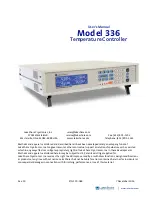
CHAPTER 5: SETTINGS
INPUTS/OUTPUTS
L90 LINE CURRENT DIFFERENTIAL SYSTEM – INSTRUCTION MANUAL
5-417
5
For example, the trip circuit current is monitored by providing a current threshold detector in series with some Form-A
contacts (see the trip circuit example in the Digital Elements section). The monitor sets a flag (see the specifications for
Form-A). The name of the FlexLogic operand set by the monitor, consists of the output relay designation, followed by the
name of the flag; for example,
Cont OP 1 IOn
.
In most breaker control circuits, the trip coil is connected in series with a breaker auxiliary contact used to interrupt current
flow after the breaker has tripped, to prevent damage to the less robust initiating contact. This can be done by monitoring
an auxiliary contact on the breaker which opens when the breaker has tripped, but this scheme is subject to incorrect
operation caused by differences in timing between breaker auxiliary contact change-of-state and interruption of current in
the trip circuit. The most dependable protection of the initiating contact is provided by directly measuring current in the
tripping circuit, and using this parameter to control resetting of the initiating relay. This scheme is often called trip seal-in.
This can be realized using the
Cont OP 1 IOn
FlexLogic operand to seal-in the contact output as follows:
CONTACT OUTPUT H1 ID
: “
Cont Op 1
"
OUTPUT H1 OPERATE
: any suitable FlexLogic operand
OUTPUT H1 SEAL-IN
: “
Cont Op 1 IOn
”
CONTACT OUTPUT H1 EVENTS
: “Enabled”
Figure 5-232: Contact input/output module type 6A contact 1 logic
5.9.3.2 Latching outputs
SETTINGS
INPUTS/OUTPUTS
CONTACT OUTPUTS
CONTACT OUTPUT H1a
The latching output contacts are mechanically bi-stable and controlled by two separate (open and close) coils. As such
they retain their position even if the relay is not powered up. The relay recognizes all latching output contact cards and
populates the setting menu accordingly. On power up, the relay reads positions of the latching contacts from the hardware
before executing any other functions of the relay (such as protection and control features or FlexLogic).
The latching output modules, either as a part of the relay or as individual modules, are shipped from the factory with all
latching contacts opened. It is highly recommended to double-check the programming and positions of the latching
contacts when replacing a module.
Since the relay asserts the output contact and reads back its position, it is possible to incorporate self-monitoring
capabilities for the latching outputs. If any latching outputs exhibits a discrepancy, the LATCHING OUTPUT ERROR self-test
error is declared. The error is signaled by the
LATCHING OUT ERROR
FlexLogic operand, event, and target message.
CONTACT OUTPUT H1a
OUTPUT H1a ID
L-Cont Op 1
Range: up to 20 alphanumeric characters
OUTPUT H1a OPERATE:
Off
Range: FlexLogic operand
OUTPUT H1a RESET:
Off
Range: FlexLogic operand
OUTPUT H1a TYPE:
Operate-dominant
Range: Operate-dominant, Reset-dominant
OUTPUT H1a EVENTS:
Disabled
Range: Disabled, Enabled
















































